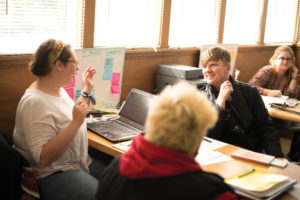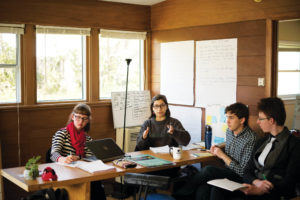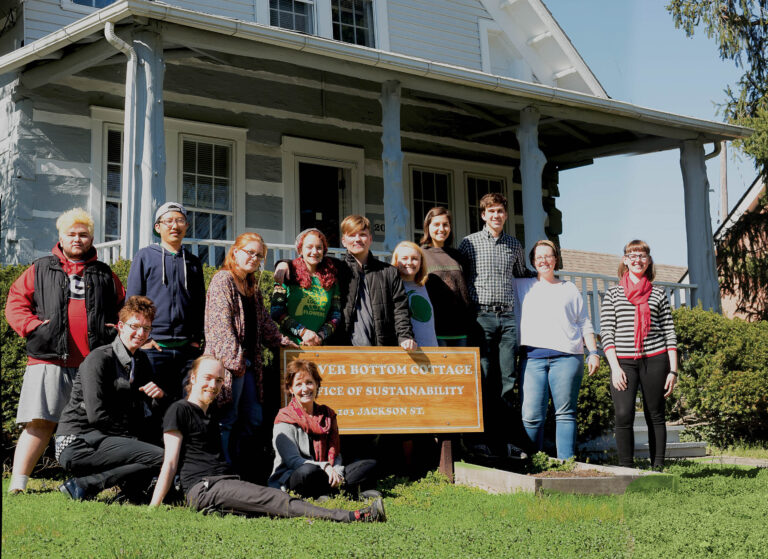Flexible scheduling. Cloud-based computing. Open office space. Soon these touchstone concepts of modern work life may be joined by a new one – dynamic governance. Some students at Berea are experiencing this model of workplace organization firsthand through their Labor Program positions in the Office of Sustainability.
Students working with Joan Pauly, sustainability coordinator, have spent the last year in this system. Unlike a traditional office model in which a supervisor creates a plan to achieve a set of goals and then delegates oversight of particular tasks, dynamic governance employs a ground-up approach. Workers and managers, staff and students are responsible for identifying challenges and opportunities, then creating a plan to address the situation.

For the Office of Sustainability, dynamic governance offered the opportunity to find better ways to meet the challenge of making the mission of sustainability tangible, accessible and visible. For example, convincing the campus community to “rethink, reduce, reuse and recycle” requires campus wide coordination and education. Pauly believes Berea can become a zero- waste institution, but coordination across many departments is essential, and dynamic governance has been a good tool for the job.
How does dynamic governance work? Though there are several models, the form Pauly uses is based on the one she “experienced when the United States Green Building Council (USGBC – the originators of the LEED Green Building rating system) decided to shift how it governed.” She describes it as a “consensus decision-making model based on the practices of the Quakers to show up to meetings prepared and to be respectful of others.” Each team member has an area of responsibility and is expected to be actively engaged in finding problems and areas for improvement. As these areas are identified, students apply their critical thinking skills by developing a proposal to share with the team. There is also an operational component to every dynamic governance–style meeting. There is a balance between proposals and full consent decision-making and the “where do things stand and what do we need to do to complete the project” portion of the meeting.
In the proposal process, students are responsible for answering three questions: What is the current situation? What is the problem with the current situation? What is the proposal for solving the problem? Proposals are circulated to all team members in advance of their weekly labor meetings. During the meetings, the team works together to develop the solution that will make the most effective use of their resources. As a result, the meetings are more engaging and productive, says Noah Coleman ’17, student supervisor. He believes dynamic governance “allows for those participating in the meeting to both ensure that they’re present and also make sure that they have time and a place to express what they’re doing.”
For the students, this creates a positive workplace atmosphere. “It’s a fantastic job because I get to be involved in pretty much all of the projects that are happening at once. And I love getting to see how we’re moving forward as a college with regard to sustainability, said Coleman.
In the case of Kristina Anderson ’19, communications and marketing coordinator, dynamic governance led to personal changes.

Anderson emphasized that dynamic governance “inspired me to work harder to make sure that I get my projects in and make sure that I’m doing what’s best for the whole office of sustainability.” In her prior jobs, Anderson says she was accustomed to following orders, but thanks to dynamic governance, she is more aware of how her individual work affects the work of the team. To make sure she supports her team members’ goals, Anderson now takes a more proactive approach to meeting individual goals because she better understands the connection between her work and the team’s performance.
Helping students grow and prepare for work in the modern world is one of the major goals of the Labor Program. According to Dean of Labor David Tipton, “There are over 100 work environments students can experience at Berea. Some are very traditional; others are more dynamic but each has a place in educating our students. However, the sustainability model is an excellent example of how to fully engage, educate and prepare our students to enter a rapidly changing and evolving world of work.” That world values “a strong work ethic, the ability to work in teams, leadership, critical thinking and communication skills,” said Tipton.
The real importance of dynamic governance, Pauly stated, will be what each student takes from it after graduation and applies to their personal, work and civic lives. She believes that “to see this practice done well is to experience a respectful, open, informed approach to elections and policy decisions,” which helps ensure that the “final decision is better than the individual ideas suggested at the beginning.”


